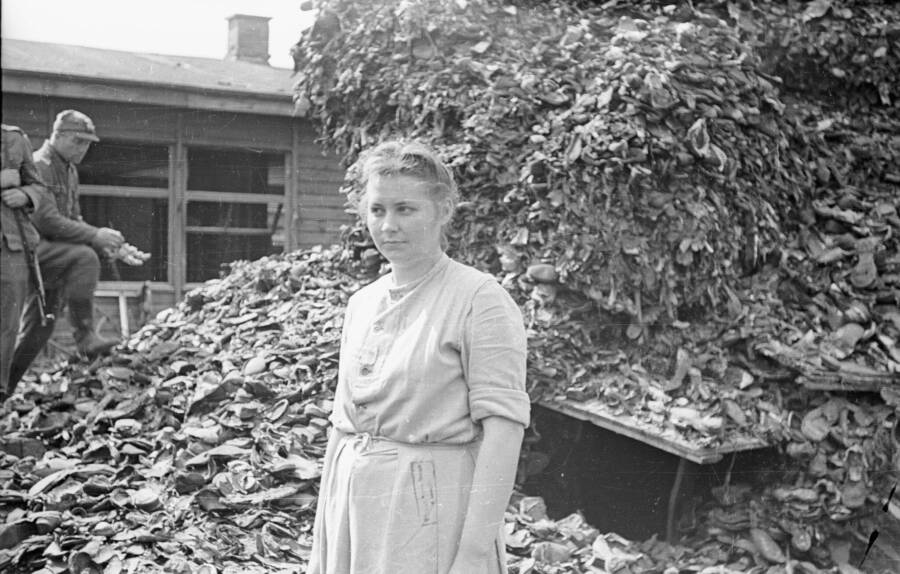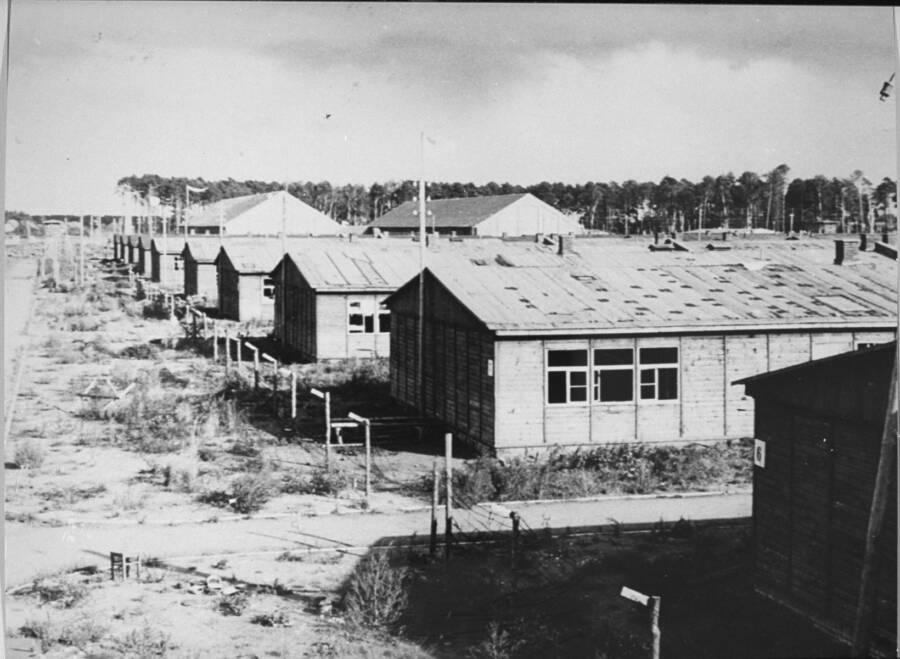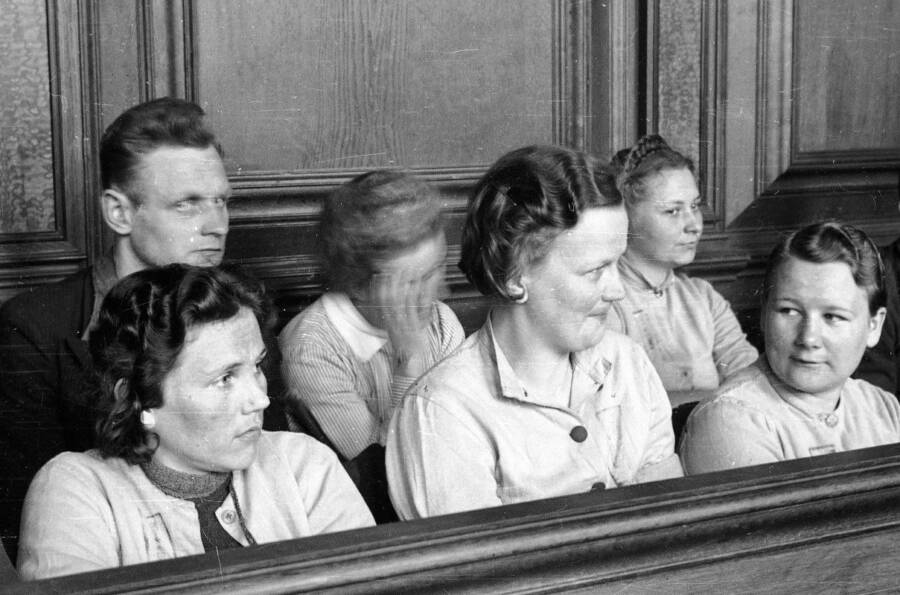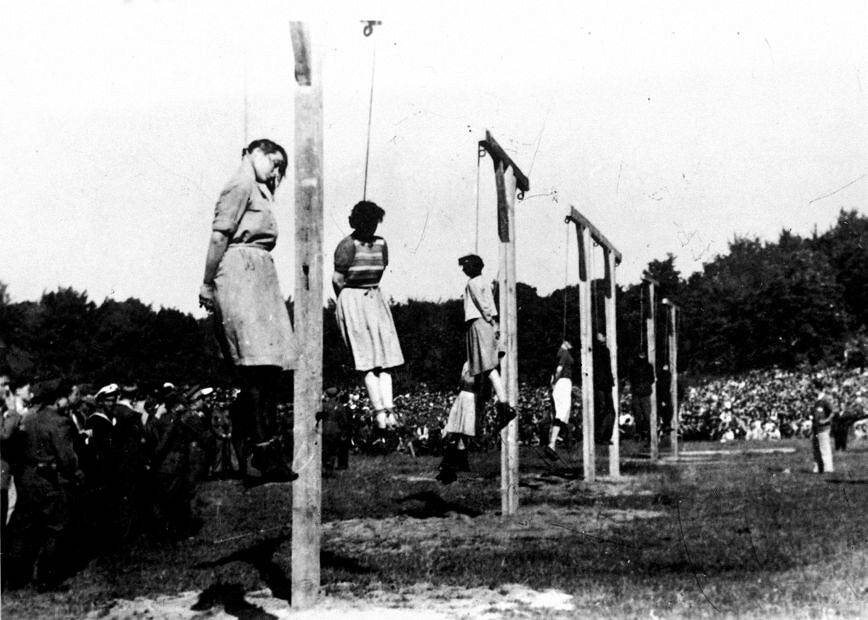Jenny-Wanda Barkmann was known for both her beauty and cruelty during her time at Stutthof concentration camp before she was hanged for her crimes in 1946.

PAP / Alamy Stock PhotoNazi guard Jenny-Wanda Barkmann in front of a pile of shoes at the Stutthof concentration camp.
The horrors of Nazi concentration camps have been well-documented throughout history, as the vile and tragic persecution of European Jews and other marginalized groups has served as a painful lesson in the years since World War II. But while much attention has been paid to the men responsible for these horrific crimes, it was often female camp guards like Jenny-Wanda Barkmann who were the cruelest.
Women like Barkmann, Irma Grese, and Elisabeth Volkenrath all became notorious at the camps for their brutality. Twenty-one would eventually face the gallows, including Barkmann, who was called the “Beautiful Spectre.”
Known in equal parts for her beauty and cruelty, the young would-be model was a guard at the Stutthof concentration camp. Though she arrived at Stutthof in 1944 — and the war ended only a year later — Jenny Barkmann quickly earned her place among the Nazis’ most wicked.
How Jenny-Wanda Barkmann Became The “Beautiful Spectre”
Jenny-Wanda Barkmann was born on May 30, 1922 in Hamburg, Germany. Though she had a normal childhood, she also came of age with the rise of Naziism. Just before Barkmann turned 11, Adolf Hitler became the chancellor of Germany. When she was 16, Jewish homes, businesses, and synagogues were attacked during Kristallnacht, including in Hamburg. Shortly thereafter, Hitler invaded Poland — and World War II began.
As Mémoires de Guerre reports, Barkmann had initially hoped to use her beauty to become a fashion model. But as the war dragged on, she changed her mind. In 1944, the 21-year-old became an Aufseherin, or a female guard, at the Stutthof concentration camp in Gdańsk, Poland.
Over the course of the war, the United States Holocaust Memorial Museum reports that as many as 100,000 people were deported to Stutthof and some 60,000 people died there. Many perished of diseases like typhus. But many more were sent to the gas chambers by the camp guards.

Public DomainThe prison barracks at Stutthof after it was liberated in May 1945.
In 1944, Barkmann became one of these guards. She was one of just 3,700 women to take on such a position — of 55,000 total guards in the Nazi concentration camps — and quickly made a name for herself as one of Stutthof camp’s most brutal Aufseherin.
She showed no hesitation when it came to beating prisoners — sometimes to death — and regularly sent women and children to the gas chambers who she and other guards found too weak or sick to work. Beautiful and brutal, Jenny-Wanda Barkmann was called the “Beautiful Spectre.”
The Fall Of The ‘Beautiful Spectre’
By the time Jenny-Wanda Barkmann secured her a reputation at Stutthof, World War II had started to come to an end. In April 1945, Adolf Hitler died by suicide in Berlin. A month later, Germany surrendered. And Barkmann, the ‘Beautiful Spectre’ fled Stutthof and went into hiding.
According Mémoires de Guerre, Barkmann — dubbed “Mad Jenny” — became one of the most wanted Nazi criminals. Barkmann managed to stay hidden for four months, but was captured at the Gdansk train station.

Public DomainFemale SS guards on trial. Jenny-Wanda Barkmann is in the back row on the right side.
During her interrogation, Barkmann claimed that she had always treated Jewish prisoners well, and even said that she’d saved some of them from death. But her interrogators eventually saw through her act.
Indeed, dozens of survivors of Stutthof testified against Barkmann in court, describing the brutal atrocities she committed as an Aufseherin. Even her lawyer admitted that Barkmann was guilty of the crimes, but argued that it was because she was mentally ill — no sane person, he suggested, could have done what she did at the concentration camp.
Meanwhile, Barkmann didn’t help her own case. Faced with accusations of brutality and murder, Barkmann responded with contemptuous laughter. She didn’t ask for forgiveness. She never shed a tear or showed any remorse.
After she was sentenced to die by hanging, Jenny-Wanda Barkmann said: “Life is really a great pleasure, and pleasure, as a rule, does not last long.”
Jenny Barkmann’s Execution In Gdańsk
On July 4, 1946, Jenny Barkmann and 10 other war criminals were taken to Biskup Hill near Gdańsk to be hanged for their crimes. As many as 200,000 people were in attendance, anxiously awaiting the moment of execution.
The executioners didn’t bother with formality. The criminals were not granted the honor of being put to death by a professional executioner. They were placed on the bed of a truck with a noose tied around their necks. Then, the truck drove off. Gravity did the work.

Public DomainThe public hanging of Jenny Barkmann and other Stutthof war criminals.
After the noose had been tied around Barkmann’s neck, however, the truck she stood on wouldn’t start. The crowd let out a murmur of frustration as Barkmann stood before them, still alive. Then, a former Stutthof prisoner ran up and pushed Barkmann off the truck bed.
Jenny-Wanda Barkmann died instantly. She was 24 years old.
As her body swayed in the breeze, scores of people in the crowd flocked to her body, trying to rip off a piece of fabric or a button to keep as a souvenir. Eventually, her corpse was sent to the Anatomical Theater in Gdansk, along with the bodies of other criminals, to be used as a visual aid for medical students. It was later disposed of as biological waste.
But the hatred for Jenny-Wanda Barkmann was great, and at one point, a rumor spread that her body had actually been cremated and the ashes taken to Barkmann’s hometown of Hamburg. The rumor claimed that her ashes were then dumped into a toilet and flushed away.
Of course, it was just a rumor.
After reading about the brutal crimes of Jenny-Wanda Barkmann, learn the true story of another Nazi criminal, Amon Goeth. Or, discover the story of the 101-year-old Nazi guard who was convicted in 2022 of over 3,000 murders.





